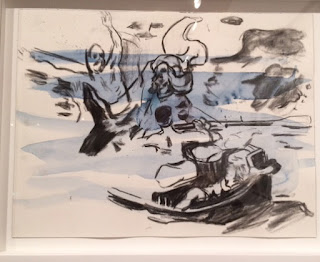I was over in Manchester this week and
finally had a chance to catch up with the Cecily Brown Shipwreck drawings
exhibition at the Whitworth. The exhibition is on until the 15th of
April so those of you thinking of going to see some drawings over Easter could
easily fit this exhibition in.
The drawings were framed in deep set box
frames and glazed behind glass, so please forgive the quality of the images, it
is always hard to avoid light reflection when trying to record things behind
glass.
Cecily Brown is a very
interesting artist, in particular because of her often quoted desire to work in
that gap “where figuration and
abstraction meet”. She is in this instance working from a series of old master
paintings, all of which address the horror of death at sea. Her practice could
be described as a deconstruction of the past in order to re-imagine images for
today. Her paintings come out of an iterative
process of drawing and re-drawing from selected images from the past, a process
she continues until she is able to internalise the information taken from the pictorial
constructions she is confronting.
She attempts
to bring an old tradition of history painting back into the present tense by
interrogating figure relationships, highlighting selected rhythmic passages and
the way line can cut through colour in different compositional variations or by
exploring how marks can re-energise themselves when uncoupled from the
preciseness of the original contours of form.
Gericault: The Raft of the Medusa
Delacroix: Christ Asleep During the Tempest
Delacroix: The Shipwreck of Don Juan
The images she has drawn from are very familiar; Gericault’s The
Raft of the Medusa of 1819, Delacroix’s ‘Christ Asleep During
the Tempest’ of 1853 and ‘The Shipwreck of Don Juan’ from
1840. These paintings being not only icons of French Romanticism but perhaps still of
resonance because of the fact that the continuing migrant crisis keeps us aware of tragic deaths at sea.
I have tried to deal with the subject myself and realise how difficult
is to make images that resonate with a contemporaneity and yet at the same time
tap into the deep roots of human history. Brown’s approach is to do this by
trying to find the motion of being in a rocking, wave tossed small boat in the
movements of people, and to find these movements in classical paintings. The artist is trying to
extract the human tragedy from these images by focusing on how bodies shape
themselves as they engage in tragic events. According to the British Red Cross,
approximately 5,000 asylum seekers arriving in the UK each year are resettled
in Greater Manchester, and from my own experience when talking to refugees
arriving in Leeds many of them will have at some point have had to cross the
Mediterranean in small not very sea worthy boats.
Cecily
Brown has stated that her drawings are an alternative “way of approaching a
deeply difficult subject”. Subjects of
this sort are emotionally charged, and sometimes it is useful for an artist to
tap into the resources of history in order to avoid simply hand wringing or emotive
bluster. The references to other lives at other times in many ways giving
gravitas to her response and providing a network of connections that can help
an observer come to terms with a continuing aspect of the human condition.
Cecily Brown: Shipwreck painting
See also:















The paint art is so good...
ReplyDeleteHow to pass Nebosh IGC3
Nebosh IGC Registration
IOSH MS course in Chennai
Nebosh Course in Chennai
Safety Courses in India
Fabulous Content.
ReplyDeleteShop Drawings Preparation in USA